Roland VS-880EX User Manual
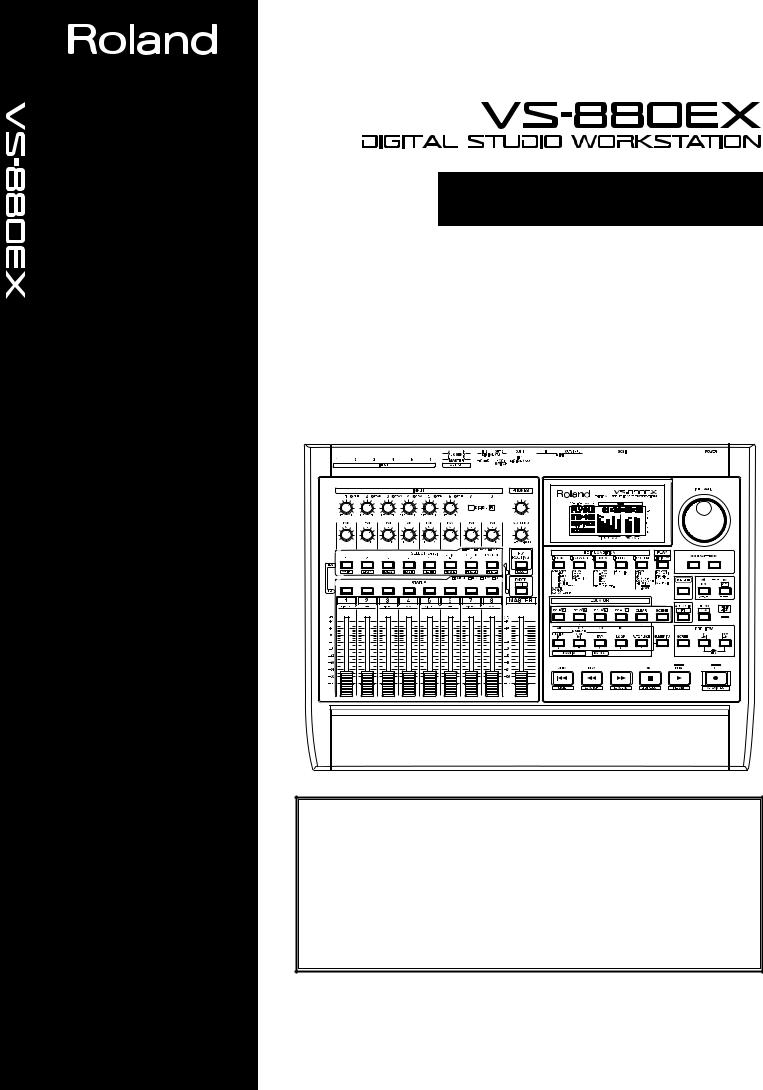
®
OWNER'S MANUAL
MANUAL OWNER'S
Before using this unit, carefully read the sections entitled: “IMPORTANT SAFETY INSTRUCTIONS” (p. 2), “USING THE UNIT SAFELY” (p. 3, 4), and “IMPORTANT NOTES” (p. 5). These sections provide important information concerning the proper operation of the unit. Additionally, in order to feel assured that you have gained a good grasp of every feature provided by your new unit, Quick Start, Owner’s Manual, and Appendices should be read in its entirety. The manual should be saved and kept on hand as a convenient reference.
Copyright © 1998 ROLAND CORPORATION
All rights reserved. No part of this publication may be reproduced in any form without the written permission of ROLAND CORPORATION.
Roland Homepage http://www.rolandcorp.com/
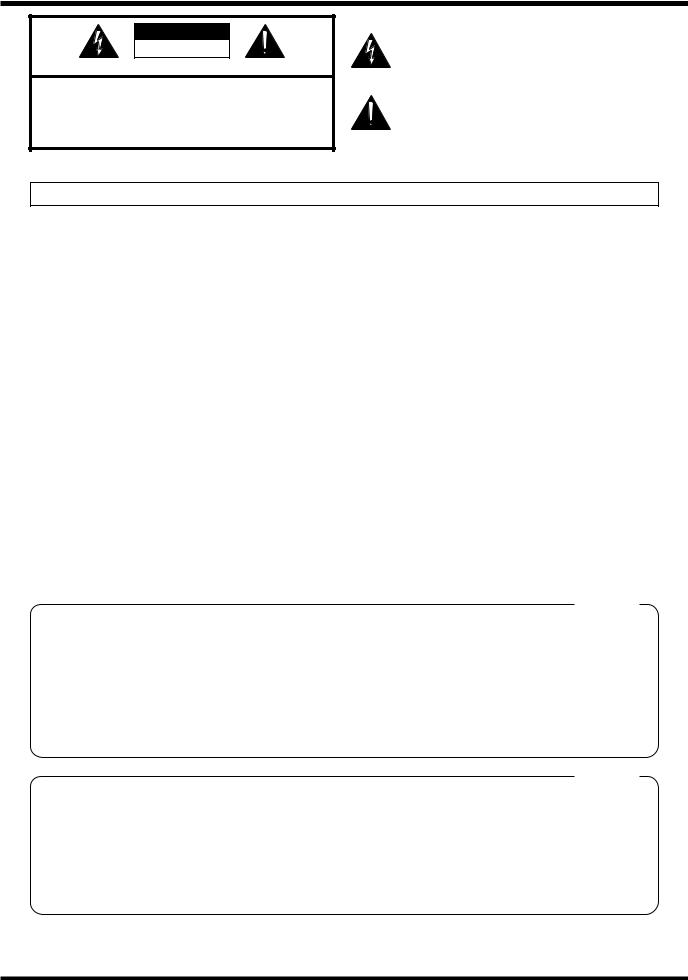
CAUTION
RISK OF ELECTRIC SHOCK
DO NOT OPEN
ATTENTION: RISQUE DE CHOC ELECTRIQUE NE PAS OUVRIR
CAUTION: TO REDUCE THE RISK OF ELECTRIC SHOCK,
DO NOT REMOVE COVER (OR BACK).
NO USER-SERVICEABLE PARTS INSIDE.
REFER SERVICING TO QUALIFIED SERVICE PERSONNEL.
The lightning flash with arrowhead symbol, within an equilateral triangle, is intended to alert the user to the presence of uninsulated “dangerous voltage” within the product’s enclosure that may be of sufficient magnitude to constitute a risk of electric shock to persons.
The exclamation point within an equilateral triangle is intended to alert the user to the presence of important operating and maintenance (servicing) instructions in the literature accompanying the product.
INSTRUCTIONS PERTAINING TO A RISK OF FIRE, ELECTRIC SHOCK, OR INJURY TO PERSONS.
IMPORTANT SAFETY INSTRUCTIONS SAVE THESE INSTRUCTIONS
WARNING - When using electric products, basic precautions should always be followed, including the following:
1.Read all the instructions before using the product.
2.Do not use this product near water — for example, near a bathtub, washbowl, kitchen sink, in a wet basement, or near a swimming pool, or the like.
3.This product should be used only with a cart or stand that is recommended by the manufacturer.
4.This product, either alone or in combination with an amplifier and headphones or speakers, may be capable of producing sound levels that could cause permanent hearing loss. Do not operate for a long period of time at a high volume level or at a level that is uncomfortable. If you experience any hearing loss or ringing in the ears, you should consult an audiologist.
5.The product should be located so that its location or position does not interfere with its proper ventilation.
6.The product should be located away from heat sources such as radiators, heat registers, or other products that produce heat.
7.The product should be connected to a power supply only of the type described in the operating instructions or as marked on the product.
8.The power-supply cord of the product should be unplugged from the outlet when left unused for a long period of time.
9.Care should be taken so that objects do not fall and liquids are not spilled into the enclosure through openings.
10.The product should be serviced by qualified service personnel when:
A.The power-supply cord or the plug has been damaged; or
B.Objects have fallen, or liquid has been spilled into the product; or
C.The product has been exposed to rain; or
D.The product does not appear to operate normally or exhibits a marked change in performance; or
E.The product has been dropped, or the enclosure damaged.
11.Do not attempt to service the product beyond that described in the user-maintenance instructions. All other servicing should be referred to qualified service personnel.
For the USA
GROUNDING INSTRUCTIONS
This product must be grounded. If it should malfunction or breakdown, grounding provides a path of least resistance for electric current to reduce the risk of electric shock.
This product is equipped with a cord having an equipment-grounding conductor and a grounding plug. The plug must be plugged into an appropriate outlet that is properly installed and grounded in accordance with all local codes and ordinances.
DANGER: Improper connection of the equipment-grounding conductor can result in a risk of electric shock. Check with a qualified electrician or serviceman if you are in doubt as to whether the product is properly grounded.
Do not modify the plug provided with the product — if it will not fit the outlet, have a proper outlet installed by a qualified electrician.
For the U.K.
WARNING: THIS APPARATUS MUST BE EARTHED
IMPORTANT: THE WIRES IN THIS MAINS LEAD ARE COLOURED IN ACCORDANCE WITH THE FOLLOWING CODE. GREEN-AND-YELLOW: EARTH, BLUE: NEUTRAL, BROWN: LIVE
As the colours of the wires in the mains lead of this apparatus may not correspond with the coloured markings identifying the terminals in your plug, proceed as follows:
The wire which is coloured GREEN-AND-YELLOW must be connected to the terminal in the plug which is marked by the letter E or by the safety earth symbol or coloured GREEN or GREEN-AND-YELLOW.
or coloured GREEN or GREEN-AND-YELLOW.
The wire which is coloured BLUE must be connected to the terminal which is marked with the letter N or coloured BLACK. The wire which is coloured BROWN must be connected to the terminal which is marked with the letter L or coloured RED.
The product which is equipped with a THREE WIRE GROUNDING TYPE LINE PLUG must be grounded.
2
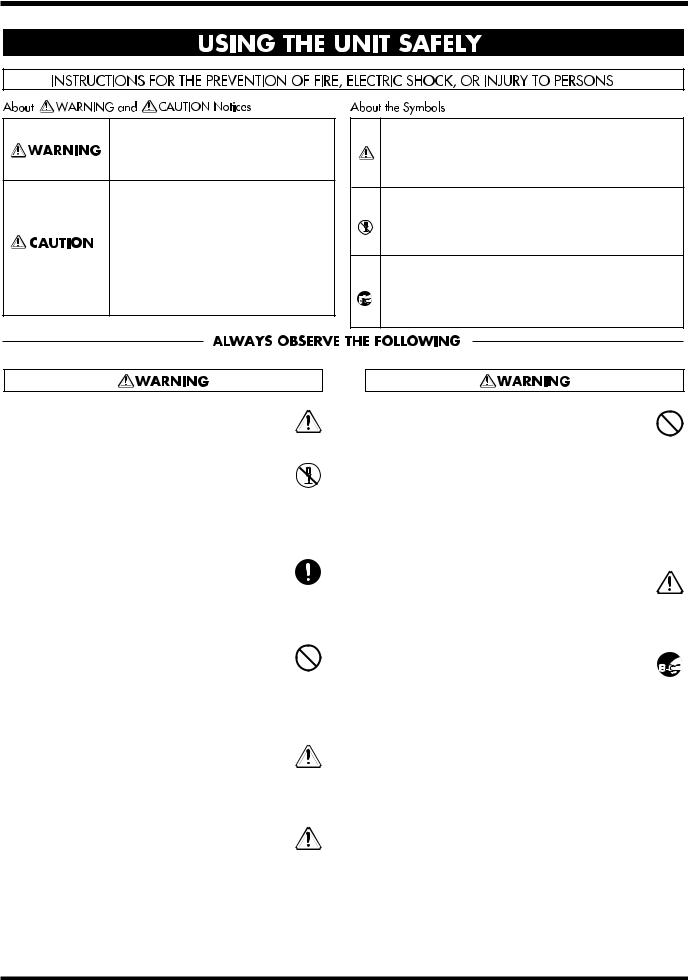
USING THE UNIT SAFELY
Used for instructions intended to alert the user to the risk of death or severe injury should the unit be used improperly.
Used for instructions intended to alert the user to the risk of injury or material damage should the unit be used improperly.
* Material damage refers to damage or other adverse effects caused with respect to the home and all its furnishings, as well to domestic animals or pets.
• Before using this unit, make sure to read the instructions below, and the Owner’s Manual.
...........................................................................................................
•Do not open or perform any internal modifications on the unit. (The only exception would be where this manual provides specific instructions which should be followed in order to put in place user-
installable options; see Quick Start p. 49.)
...........................................................................................................
• Make sure you always have the unit placed so it is level and sure to remain stable. Never place it on stands that could wobble, or on inclined surfaces.
...........................................................................................................
•Avoid damaging the power cord. Do not bend it excessively, step on it, place heavy objects on it, etc.
A damaged cord can easily become a shock or fire hazard. Never use a power cord after it has been damaged.
...........................................................................................................
• In households with small children, an adult should provide supervision until the child is capable of following all the rules essential for the safe operation
of the unit.
...........................................................................................................
• Protect the unit from strong impact. (Do not drop it!)
The symbol alerts the user to important instructions or warnings.The specific meaning of the symbol is determined by the design contained within the triangle. In the case of the symbol at left, it is used for general cautions, warnings, or alerts to danger.
symbol alerts the user to important instructions or warnings.The specific meaning of the symbol is determined by the design contained within the triangle. In the case of the symbol at left, it is used for general cautions, warnings, or alerts to danger.
The  symbol alerts the user to items that must never be carried out (are forbidden). The specific thing that must not be done is indicated by the design contained within the circle. In the case of the symbol at left, it means that the unit must never be disassembled.
symbol alerts the user to items that must never be carried out (are forbidden). The specific thing that must not be done is indicated by the design contained within the circle. In the case of the symbol at left, it means that the unit must never be disassembled.
The ● symbol alerts the user to things that must be carried out. The specific thing that must be done is indicated by the design contained within the circle. In the case of the symbol at left, it means that the powercord plug must be unplugged from the outlet.
•Do not force the unit’s power-supply cord to share an outlet with an unreasonable number of other devices. Be especially careful when using extension cords—the total power used by all devices you have connected to the extension cord’s outlet must never exceed the power rating (watts/amperes) for the
extension cord. Excessive loads can cause the insulation on the cord to heat up and eventually melt through.
...........................................................................................................
•Before using the unit in a foreign country, consult with your retailer, the nearest Roland Service
Center, or an authorized Roland distributor, as listed on the “Information” page.
...........................................................................................................
•Always turn the unit off and unplug the power cord  before attempting installation of the Hard disk drive unit (HDP88 series: Quick Start p. 49).
before attempting installation of the Hard disk drive unit (HDP88 series: Quick Start p. 49).
3
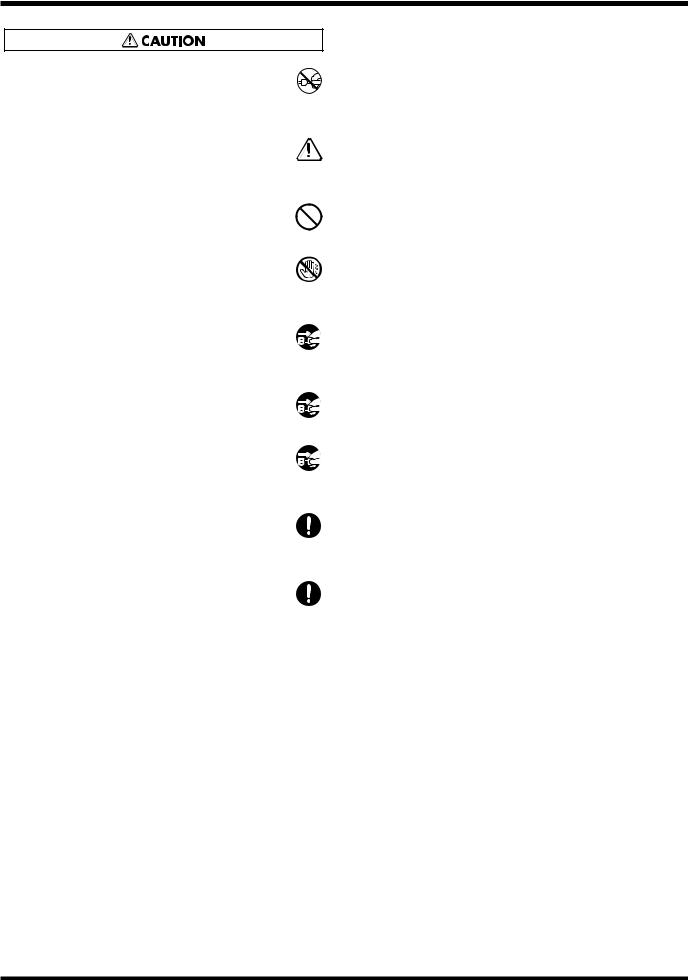
USING THE UNIT SAFELY
•Always grasp only the plug on the power-supply cord when plugging into, or unplugging from, an
outlet or this unit.
...........................................................................................................
•Try to prevent cords and cables from becoming entangled. Also, all cords and cables should be
placed so they are out of the reach of children.
...........................................................................................................
•Never climb on top of, nor place heavy objects on the unit.
...........................................................................................................
• Never handle the power cord or its plugs with wet hands when plugging into, or unplugging from, an outlet or this unit.
...........................................................................................................
•Before moving the unit, disconnect the power plug from the outlet, and pull out all cords from external devices.
...........................................................................................................
• Before cleaning the unit, turn off the power and unplug the power cord from the outlet (p. 33).
...........................................................................................................
• Whenever you suspect the possibility of lightning in your area, pull the plug on the power cord out of the outlet.
...........................................................................................................
• When installing the Hard disk drive unit (HDP88 series), remove only the specified screws (Quick Start p. 49).
...........................................................................................................
• If you use the optical connector, be sure that the connector cover you removed is placed out of the reach of children.
4

IMPORTANT NOTES
In addition to the items listed under “IMPORTANT SAFETY INSTRUCTIONS” and “USING THE UNIT SAFELY” on pages 2–4, please read and observe the following:
Power Supply
●Do not use this unit on the same power circuit with any device that will generate line noise (such as an electric motor or variable lighting system).
●Before connecting this unit to other devices, turn off the power to all units. This will help prevent malfunctions and/or damage to speakers or other devices.
Placement
●Using the unit near power amplifiers (or other equipment containing large power transformers) may induce hum. To alleviate the problem, change the orientation of this unit; or move it farther away from the source of interference.
●This device may interfere with radio and television reception. Do not use this device in the vicinity of such receivers.
●Do not expose the unit to direct sunlight, place it near devices that radiate heat, leave it inside an enclosed vehicle, or otherwise subject it to temperature extremes. Excessive heat can deform or discolor the unit.
Maintenance
●For everyday cleaning wipe the unit with a soft, dry cloth or one that has been slightly dampened with water. To remove stubborn dirt, use a cloth impregnated with a mild, non-abrasive detergent. Afterwards, be sure to wipe the unit thoroughly with a soft, dry cloth.
●Never use benzine, thinners, alcohol or solvents of any kind, to avoid the possibility of discoloration and/or deformation.
Repairs and Data
●Please be aware that all data contained in the unit’s memory may be lost when the unit is sent for repairs. Important data should always be backed up on a storage device (e.g., hard disk or Zip disk) or DAT recorder, or written down on paper (when possible). During repairs, due care is taken to avoid
the loss of data. However, in certain cases (such as when circuitry related to memory itself is out of order), we regret that it may not be possible to restore the data, and Roland assumes no liability concerning such loss of data.
Additional Precautions
●Please be aware that the contents of memory can be irretrievably lost as a result of a malfunction, or the improper operation of the unit. To protect yourself against the risk of loosing important data, we recommend that you periodically save a backup copy of important data you have stored in the unit’s memory on a storage device (e.g., hard disk or Zip disk), or DAT recorder.
●Unfortunately, it may be impossible to restore the contents of data that was stored on a storage device (e.g., hard disk or Zip disk), or DAT recorder once it has been lost. Roland Corporation assumes no liability concerning such loss of data.
●Use a reasonable amount of care when using the unit’s buttons, sliders, or other controls; and when using its jacks and connectors. Rough handling can lead to malfunctions.
●Never strike or apply strong pressure to the display.
●A small amount of noise may be heard from the display during normal operation.
●When connecting / disconnecting all cables, grasp the connector itself—never pull on the cable. This way you will avoid causing shorts, or damage to the cable’s internal elements.
●A small amount of heat will radiate from the unit during normal operation.
●To avoid disturbing your neighbors, try to keep the unit’s volume at reasonable levels. You may prefer to use headphones, so you do not need to be concerned about those around you (especially when it is late at night).
●When you need to transport the unit, package it in the box (including padding) that it came in, if possible. Otherwise, you will need to use equivalent packaging materials.
If an internal IDE hard disk (HDP88 series) is installed, then remove the hard disk. Place the hard disk in its carton and set this in the specified place inside the VS-880EX shipping carton. The unit is now ready to be transported. Moving the VS-880EX with the hard disk installed may result in loss of song data or damage to the hard disk.
5
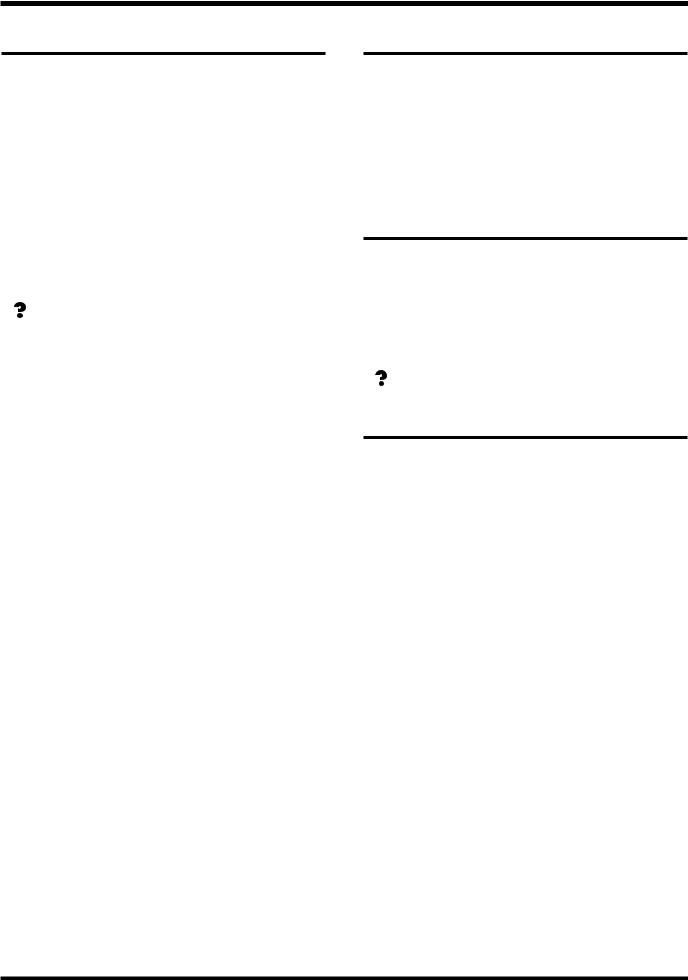
IMPORTANT NOTES
Handling the Disk Drive
For details on hard disk handling, refer also to the instructions that accompanied your hard disk.
●Before performing any of the following actions, be sure to perform the shutdown procedure. Failure to do so may result in loss of song data or damage to the hard disk.
•Turning off the power of the VS-880EX
•Turning off the power of the Zip drive connected with SCSI connector
•Removing a disk from a Zip drive connected with SCSI connector
Shutdown (Appendices p. 124)
When the VS-880EX MIDI/DISK indicator or Zip drive status indicator is lit, it means that data is being written to or from the hard disk. If you are using a Zip drive, confirm that this indicator is not lit before removing disks.
●While using the VS-880EX, be careful not to subject the unit to vibration or shock, and avoid moving the unit while the power is turned on.
●Install the unit on a solid, level surface in an area free from vibration. If the unit must be installed at an angle, be sure the installation does not exceed the permissible range.
●Avoid using the unit immediately after it has been moved to a location with a level of humidity that is greatly different than its former location. Rapid changes in the environment can cause condensation to form inside the drive, which will adversely affect the operation of the drive and/or damage removable disks. When the unit has been moved, allow it to become accustomed to the new environment (allow a few hours) before operating it.
Concerning Copyright
The law prohibits the unauthorized recording, public performance, broadcast, sale, or distribution etc. of a work (CD recording, video recording, broadcast, etc.) whose copyright is owned by a third party.
Roland will take no responsibility for any infringement of copyright that you may commit in using the VS-880EX.
About SCMS
The VS-880EX does not implement SCMS. This design decision was made with the intent that SCMS should not restrict the creation of original compositions which do not violate copyright law. Do not use this device in a way which would infringe on copyrights held by another.
SCMS (Appendices p. 124)
Disclaimer of Liability
Roland will take no responsibility for any direct damages, consequential damages, or any other damages which may result from your use of the VS-880EX. These damages may include but are not limited to the following events which can occur when using the VS880EX.
●Any loss of profit that may occur to you.
●Permanent loss of your music or data.
●Inability to continue using the VS-880EX itself or a connected device.
About the License Agreement
The VS-880EX and its CD-R capability are designed to allow you to reproduce material to which you have copyright, or material which the copyright owner has granted you permission to copy. Accordingly, reproduction of music CDs or other copyrighted material without the permission of the copyright owner, other than for your own personal use and enjoyment (private use) constitutes copyright infringement, which may incur penalties. Consult a copyright specialist or special publications for more detailed information on obtaining such permission from copyright holders.
6

CONTENTS |
|
Preparations .......................................................................... |
12 |
About the Package Contents ...................................................................................... |
12 |
Main Features ............................................................................................................. |
12 |
Front and Rear Panels .......................................................... |
14 |
Mixer Section .............................................................................................................. |
14 |
Recorder Section ........................................................................................................ |
16 |
Display section ............................................................................................................ |
18 |
Rear Panel .................................................................................................................. |
19 |
Chapter 1 Before You Start (VS-880EX Terminology) ........ |
21 |
Saving and Managing Data ......................................................................................... |
21 |
Managing Disk Contents (Partitioning) ......................................................................... |
21 |
The Location Where a Performance is Recorded (Song) ............................................. |
22 |
Sources, Tracks, and Channels ........................................................................................ |
22 |
About Events ...................................................................................................................... |
23 |
Mixer Section .............................................................................................................. |
24 |
Signal Flow (Buses) ........................................................................................................... |
24 |
Input Mixer ......................................................................................................................... |
26 |
Track Mixer ......................................................................................................................... |
27 |
Effect Return Mixer ........................................................................................................... |
27 |
Switching the Fader Functions ........................................................................................ |
28 |
Master Block ....................................................................................................................... |
28 |
Recorder Section ........................................................................................................ |
28 |
Differences with a Tape-Type MTR ................................................................................ |
28 |
Track Minutes and Recording Time ............................................................................... |
29 |
Auxiliary Tracks for Each Track ...................................................................................... |
30 |
Effects Section ............................................................................................................ |
31 |
About the Effect Expansion Board .................................................................................. |
31 |
Connecting Effects ............................................................................................................. |
31 |
Chapter 2 Basic Operation ................................................... |
32 |
Before You Begin ........................................................................................................ |
32 |
Turning On the Power ...................................................................................................... |
32 |
If You Have Trouble Understanding Displays or Operations .................................... |
32 |
Before You Finish Operations ..................................................................................... |
32 |
Saving the Performance to Disk (Song Store) ................................................................ |
32 |
Turning Off the Power ...................................................................................................... |
33 |
Restarting ............................................................................................................................ |
33 |
Basic Operations on the VS-880EX ............................................................................ |
34 |
Display Each of the Condition Menus ............................................................................ |
34 |
Selecting Pages Contained in Functions and Settings .................................................. |
34 |
Select the Setting You Want to Change .......................................................................... |
35 |
Change the Settings Values .............................................................................................. |
35 |
Execute the Operation ....................................................................................................... |
35 |
Switching Track Conditions ......................................................................................... |
35 |
Changing the Current Time ......................................................................................... |
36 |
Moving in Frame Units ..................................................................................................... |
36 |
Moving in Measure/Beat Units ....................................................................................... |
36 |
Moving to the Beginning or End of the Performance .................................................. |
36 |
Storing a Time Location .............................................................................................. |
36 |
Using the Locator ............................................................................................................... |
37 |
Using Markers .................................................................................................................... |
38 |
Chapter 3 Multi-Track Recording ......................................... |
40 |
Recording .................................................................................................................... |
40 |
Items Necessary for Multi-Track Recording .................................................................. |
40 |
Creating a New Song (Song New) .................................................................................. |
40 |
7

CONTENTS
General Course of the Recording Process ................................................................. |
41 |
Connecting Instruments .............................................................................................. |
41 |
Recording to the Tracks .............................................................................................. |
42 |
Saving a Recorded Performance (Song Store) ........................................................... |
43 |
Recording Over a Portion of a Performance (Punch-In/Punch-Out) ........................... |
44 |
Using the RECORD Button (Manual Punch-In 1) ......................................................... |
44 |
Using the Foot switch (Manual Punch-In 2) .................................................................. |
44 |
Specifying Beforehand the Location for Rerecording (Auto Punch-In) .................... |
45 |
Repeatedly Recording Over the Same Area (Loop Recording) .................................. |
47 |
Recording to Other Tracks (Overdubbing) .................................................................. |
49 |
Recording on V-Track 2 .................................................................................................... |
49 |
Using Effects ............................................................................................................... |
50 |
Applying Effects to the Playback .................................................................................... |
50 |
Applying Effects While Recording (Send/Return) ...................................................... |
51 |
Applying Effects While Recording (Insert) .................................................................... |
52 |
Recording Digital Signals ............................................................................................ |
55 |
Items Necessary for Digital Recording ........................................................................... |
55 |
Make the Digital Connections ......................................................................................... |
55 |
Match the Sample Rates .................................................................................................... |
55 |
Select the Master Clock ..................................................................................................... |
56 |
Select an Input Source ....................................................................................................... |
56 |
Adjusting the Tone (Equalizer) .................................................................................... |
57 |
Using the 3-Band Equalizer .............................................................................................. |
57 |
Adjusting the Equalizer .................................................................................................... |
57 |
Combining the Contents of Tracks (Track Bouncing) ................................................. |
60 |
Applying Reverb While Track Bouncing ....................................................................... |
61 |
Creating a Master Tape .............................................................................................. |
63 |
To Record to a Cassette Tape ........................................................................................... |
63 |
Recording with DAT and MD Recorders ....................................................................... |
63 |
Protecting Songs (Song Protect) ................................................................................. |
64 |
Protecting Performances ................................................................................................... |
65 |
To Remove Song Protect ................................................................................................... |
65 |
Selecting a Song (Song Select) .................................................................................. |
65 |
Chapter 4 Using the Internal Effects ................................... |
66 |
Composition of the Effects .......................................................................................... |
66 |
Connecting the Effects ................................................................................................ |
66 |
Changing the Source Sound Itself (Insert) ..................................................................... |
66 |
Inserting with Input and Track Channels ...................................................................... |
67 |
Inserting an Effect into the Master Block ....................................................................... |
67 |
Adding the Sound with the Effect Applied to the Direct Sound (Send/Return) ..... |
68 |
Selecting Effects (Patch) ............................................................................................. |
70 |
Creating New Effects Sounds ..................................................................................... |
71 |
When Saving to User Patches .......................................................................................... |
72 |
When Storing to a Scene ................................................................................................... |
72 |
Chapter 5 Storing Mixer Settings ......................................... |
73 |
Recording the Current Condition of the Mixer (Scene) ............................................... |
73 |
Making Mixer Settings Automatically(EZ Routing) ...................................................... |
74 |
Recalling Recording Settings (Recording/Template) .................................................. |
75 |
Recalling Track Bouncing Settings (Bouncing/Template) .......................................... |
75 |
Recalling Mixdown Settings (Mixdown/Template) .................................................... |
76 |
Storing Recording Settings (Recording/Step Edit) ...................................................... |
77 |
Storing Track Bouncing Settings (Bouncing/Step Edit) .............................................. |
81 |
Storing Mixdown Settings (Mixdown/Step Edit) ........................................................ |
84 |
Saving the Current Routing (User Routing) .................................................................. |
87 |
Recalling User Routing ..................................................................................................... |
87 |
Deleting User Routings ..................................................................................................... |
87 |
8

CONTENTS
Chapter 6 Editing a Recorded Performance (Track Editing) ... 88
About Editing Operations ............................................................................................ |
88 |
Track Edit .................................................................................................................... |
88 |
About the Bar Display ....................................................................................................... |
88 |
Repeating Performance Data (Track Copy) ................................................................... |
89 |
Moving Performance Data (Track Move) ...................................................................... |
91 |
Exchanging Performance Data Between Tracks (Track Exchange) ............................ |
92 |
Inserting a Blank Space Into Performance Data (Track Insert) ................................... |
93 |
Deleting Performance Data (Track Cut) ......................................................................... |
94 |
Erasing Performance Data (Track Erase) ....................................................................... |
95 |
Modifying the Playback Time of the Performance Data |
|
(Time Compression/Expansion) ..... |
96 |
Chapter 7 Use with a Zip Drive ............................................ |
99 |
Before You Use a Zip Drive ........................................................................................ |
99 |
Handling the Zip Drive .................................................................................................... |
99 |
Handling Zip Disks ........................................................................................................... |
99 |
Connecting the Zip Drive ............................................................................................. |
99 |
Initializing the Disk (Drive Initialize) ........................................................................... |
100 |
Checking Disk Reliability ............................................................................................... |
101 |
Saving Performance Data to a Zip Drive (Song Copy) ............................................. |
102 |
Saving a Song to a Single Disk (Playable) ................................................................ |
103 |
To Load Data from Disks (Drive Select) .................................................................... |
104 |
When You Cannot Save a Song to a Single Disk (Archives) .................................... |
105 |
Saving to Disks (Store) .................................................................................................... |
105 |
Loading Data From Disks (Extract) .............................................................................. |
106 |
About power-save mode ........................................................................................... |
106 |
Chapter 8 Use with a CD-RW Drive .................................... |
107 |
Before You Use a CD-RW Drive ............................................................................... |
107 |
Handling the CD-RW Drive ........................................................................................... |
107 |
Handling CD-RW Discs .................................................................................................. |
107 |
Connecting the CD-RW Drive ................................................................................... |
107 |
Creating an Audio CD ............................................................................................... |
108 |
Items Necessary for Creating an Audio CD ................................................................ |
108 |
Creating a Master Data ................................................................................................... |
108 |
Writing Songs to CD-R Discs ......................................................................................... |
109 |
Auditioning (Test Listening) Songs Written to CDs (CD Player Function) ............ |
110 |
Writing Additional Songs to the Disc ........................................................................... |
111 |
Arranging and Writing Multiple Songs to Disc .......................................................... |
111 |
Writing the Song Data (Finalize) ................................................................................... |
112 |
Arranging and Writing Songs and Song Data ............................................................ |
113 |
Saving Songs to CD-RW Discs (CD-R Backup) ....................................................... |
113 |
Items Necessary for CD-R Backup ................................................................................ |
114 |
Saving Songs to CD-RW Discs ....................................................................................... |
114 |
Loading Songs From CD-RW Discs .............................................................................. |
115 |
How to Erase the Data in the CD-RW Disc ................................................................. |
115 |
Chapter 9 Use with MIDI Devices ....................................... |
116 |
Synchronizing with MIDI Sequencers ....................................................................... |
116 |
Items Necessary for Synchronization ........................................................................... |
116 |
Master and Slave .............................................................................................................. |
116 |
Using MTC ....................................................................................................................... |
116 |
Synchronization with the VS-880EX as the Reference (Master) ............................... |
117 |
Synchronization with the MIDI Sequencer as the Reference (Slave) ....................... |
118 |
Synchronizing with an External MIDI Device ............................................................ |
119 |
Using the Sync Track (Master) ....................................................................................... |
119 |
Using the Tempo Map (Master) .................................................................................... |
121 |
9

CONTENTS
Various Operations Related to Synchronized Operation .......................................... |
123 |
||
Use with a MIDI Controller ........................................................................................ |
126 |
||
Switching Track Status ................................................................................................... |
126 |
||
Switching Scenes .............................................................................................................. |
127 |
||
Switching Effects .............................................................................................................. |
127 |
||
Adjusting Effects .............................................................................................................. |
127 |
||
Chapter 10 Use with a DAT Recorder (DAT Backup) ........ |
128 |
||
Before Backing Up with DAT ..................................................................................... |
128 |
||
Items Necessary for DAT Backup ............................................................................. |
128 |
||
About the Devices Used in DAT Backup ..................................................................... |
128 |
||
Saving Song Data to a DAT Recorder (Backup) ....................................................... |
129 |
||
Loading Performance Data from a DAT Recorder (Recover) ................................... |
131 |
||
When Canceling the Recover Operation ...................................................................... |
132 |
||
Checking Names of Saved Performance Data (Name) ............................................ |
133 |
||
Checking the Recording Condition of Saved Performance Data (Verify) .................. |
134 |
||
Chapter 11 Compatibility .................................................... |
136 |
||
Disk Compatibility ...................................................................................................... |
136 |
||
VS-880 → |
VS-880EX ........................................................................................................ |
136 |
|
VS-880EX → |
VS-880 ........................................................................................................ |
136 |
|
VS-1680 → |
|
VS-880EX ...................................................................................................... |
136 |
VS-880EX → |
VS-1680 ...................................................................................................... |
137 |
|
VS-840 ↔ |
VS-880EX ........................................................................................................ |
137 |
|
Song Data Compatibility ............................................................................................ |
137 |
||
Loading VS-880 Performance Data into the VS-880EX (Song Import) .................... |
137 |
||
Converting VS-880EX Song Data for Use with the VS-880 (Song Export) .............. |
138 |
||
Chapter 12 Other Convenient Functions .......................... |
140 |
||
Previewing Techniques (Preview) ............................................................................. |
140 |
||
Using [TO] [FROM] ......................................................................................................... |
140 |
||
Using [SCRUB] ................................................................................................................. |
141 |
||
Recalling a Specific Location (Jump) ........................................................................ |
142 |
||
Recording Mixer Settings (Auto Mix) ......................................................................... |
142 |
||
Preparations for Auto Mix ............................................................................................. |
143 |
||
Recording the Mixer Settings, Method 1 (Snapshot) .................................................. |
143 |
||
Recording the Mixer Settings, Method 2 (Gradation) ................................................ |
144 |
||
Recording Fader Operations (Realtime) ....................................................................... |
144 |
||
If You Don’t Want to Record Fader Settings (Mask Fader) ....................................... |
145 |
||
Playing Back the Auto Mix ............................................................................................. |
145 |
||
Disabling Auto Mix Only on Specified Channels ....................................................... |
145 |
||
Disabling Auto Mix on All Channels ........................................................................... |
146 |
||
Undoing Recordings and Edits (Undo) ...................................................................... |
146 |
||
Recording and Editing Operations Which Can Be Undone (Undo) ......................... |
147 |
||
Canceling the Last-Performed Undo (Redo) ............................................................... |
147 |
||
Canceling Only the Very Last-Performed Operation ................................................. |
147 |
||
Listening Only to a Specific Channel (Solo/Mute) ..................................................... |
148 |
||
Listening Only to a Specific Channel ............................................................................ |
148 |
||
Muting Only to a Specific Channel ............................................................................... |
148 |
||
Simultaneously Adjusting a Stereo Source (Channel Link) ....................................... |
149 |
||
Adjusting the Faders ....................................................................................................... |
149 |
||
Adjusting the Pan ............................................................................................................ |
150 |
||
Linking Only the Faders (Fader Link) .......................................................................... |
151 |
||
Mixing In a Stereo Source (Stereo In) ....................................................................... |
152 |
||
Changing the Pitch During Playback (Vari-Pitch) ...................................................... |
152 |
||
Record/Playback Tracks When Using Vari-Pitch ...................................................... |
153 |
||
Directly Inputting Numeric Characters ...................................................................... |
153 |
||
Selecting the Method for Numeric Input ..................................................................... |
153 |
||
10

|
CONTENTS |
Sounding the Metronome .......................................................................................... |
154 |
Using an External MIDI Sound Source to Play the Metronome ............................... |
155 |
When the Disk Has Little Remaining Space ............................................................. |
156 |
Deleting Only Unneeded Performance Data (Song Optimize) ................................. |
156 |
Deleting One Song of Performance Data (Song Erase) .............................................. |
157 |
Changing the Name of Performance Data (Song Name) .......................................... |
157 |
Adjusting the Levels for Each Track .......................................................................... |
157 |
When Using Balanced Inputs .................................................................................... |
158 |
Determining Output ................................................................................................... |
158 |
MASTER Jacks ................................................................................................................. |
158 |
AUX Jacks ......................................................................................................................... |
159 |
DIGITAL OUT Connectors ............................................................................................ |
159 |
DIRECT OUT ................................................................................................................... |
160 |
Confirming That a Drive is Not Damaged (Drive Check) .......................................... |
160 |
Chapter 13 Making Global Settings and Checking Conditions .. 163 |
|
Switching the Display Content .................................................................................. |
163 |
Pre Level ........................................................................................................................... |
163 |
Post Level .......................................................................................................................... |
163 |
Play List ............................................................................................................................. |
163 |
Feder/Pan ......................................................................................................................... |
163 |
Checking the Size of a Recorded Performance ........................................................ |
164 |
System Settings for Each Song ................................................................................ |
164 |
Having the Volume Change as Soon as the Faders are Moved ................................ |
164 |
Holding Level Meter Peaks ............................................................................................ |
164 |
Checking the Remaining Disk Space ............................................................................ |
165 |
When Using the Foot Switch .......................................................................................... |
165 |
Overall Settings for the VS-880EX ............................................................................ |
166 |
Holding the function of [SHIFT] (Shift Lock) .............................................................. |
166 |
Displaying Measures and Beats .................................................................................... |
166 |
Adjusting the Button Sensitivity ................................................................................... |
167 |
Changing the VS-880EX’s SCSI ID Number ................................................................ |
167 |
When There Is No Hard Disk Installed ........................................................................ |
167 |
Changing at the Level at Which the Peak Indicator Lights ....................................... |
168 |
Overall Settings for Playback and Recording ............................................................ |
168 |
Constantly Monitoring the Input Source ..................................................................... |
168 |
Stopping Automatically .................................................................................................. |
168 |
If Noise Between Segments is Obtrusive ..................................................................... |
169 |
Resetting Mixer and System Settings to Their Original State ................................... |
169 |
Chapter 14 Takein Advantages of the VS-880EX (idea and examples) |
170 |
Synchronizing the Operations of Two VS-880EX Units ............................................ |
170 |
Settings for the Master VS-880EX .................................................................................. |
170 |
Settings for the Slave VS-880EX .................................................................................... |
172 |
Synchronizing with Cakewalk Pro Audio (MMC) ....................................................... |
173 |
Settings for the VS-880EX ............................................................................................... |
174 |
Settings for Cakewalk Pro Audio .................................................................................. |
175 |
Making Digital Connections with Cakewalk ............................................................... |
177 |
Using an External MIDI Device to Adjust the Mixer (Compu Mix) ............................. |
180 |
The Correspondence Between MIDI Channels and Controller Numbers .............. |
181 |
Preparations for Compu Mix ......................................................................................... |
182 |
Recording with Compu Mix .......................................................................................... |
183 |
To Have the Fader Movements Ignored ...................................................................... |
183 |
Synchronizing with Video Equipment ........................................................................ |
184 |
Using External Effects Devices ................................................................................. |
185 |
11

Preparations
About the Package Contents
The following items are included with the VS-880EX. Please check to make sure you have all the items.
•VS-880EX
•AC cord
•Quick Start
•Owner’s Manual (this manual)
•Appendices
Main Features
The Latest in Compact Home Studio
Environments
The VS-880EX retains all of the features of Roland’s VS-880 workstation; a revolution in the world of the home studio, with the disk recorder, digital mixer, and multi effects systematically and more organically integrated. From when you start picking mics to when you actually record to mixdown, adding effects, and on to creating the master data for playing through a PA or mastering on a CD, you can get a handle on every aspect of the recording process with the VS880EX in your home studio.
Disk Recorder Section
The digital disk recorder section provides eight playback tracks, and allows eight tracks to be recorded simultaneously. Each track has eight supplementary tracks (V-tracks), and each song can have two sets of these 64 tracks (8 tracks x 8 V-tracks). This means that a song can have a total of 128 tracks (64 V-tracks x 2 banks), giving you flexibility when you need to record multiple takes, or need a location for temporary storage for editing.
You can instantly find the location of sections in a song you want to hear repeatedly or places that you wish to record over (Locator) by placing marks at such points (Marker). These Markers are recalled by simple procedure, and you will never wait for any rewinding or fast-forwarding time.
The VS-880EX uses “non-destructive editing.” This allows you to cancel and recover up to 999 previous recording and editing operations (Undo/Redo).
Digital Mixer Section
You can store all mixer settings, including fader levels, pan, and effects. Stored settings can be recalled very simply, making it convenient in adjusting balances during mixdown and comparing mixes with effects.
Changes in settings over time, such as fader levels and pan, can also be stored (Auto Mix), so you can realize easy fade-ins and fade-outs in your mixes.
You can easily make the most appropriate mixer condition settings, including those for recording, track bouncing, and mixdown (EZ Routing).
Effects Section
A Effect is built in. This allows you to use up to two stereo effects when the VS-880 EX is used by itself.
The effect provides not only basic effects such as reverb and delay, but also effects ideal for vocals and guitar (such as guitar amp simulator) and even special effects such as RSS. The way in which each of these effects are organized by the 34 “algorithms” so that you can create new sounds easily.
The effect provides 210 read only effects setting (Preset Patches) which designed for various uses. In addition, the effect provides 100 read and write effects setting (User Patches) for changing and saving that contents. You can instantly switch between a variety of effects simply by selecting a patch.
Simple Operation
The VS-880EX can be operated as easily as conventional multi-track recorders. You will be able to enjoy the advantages of home studio from the day that you purchase it.
The custom LCD screen provides visual confirmation of many settings at once. In particular, the bar display provides a graphical indication of the level meter, pan and fader settings, and the track record status.
The LCD screen is backlit and inclined, so it is easy to read when used on stage or wherever high visibility is required.
12

Preparations
Connectivity
There are six sets of balanced input jacks, handling a wide input sensitivity range, from line level (+4 dBu) to mic level (-50 dBu).
Besides the RCA phono type (stereo) MASTER jacks, the (mono) AUX A and AUX B jacks are provided.
The VS-880EX provides both coaxial and optical digital I/O connectors. With these, you can make digital connections with popular consumer electronic devices such as CD players, DAT recorders, MD recorders, and so on.
A SCSI connector (DB-25 type) is also provided, allowing you to connect to external SCSI devices such as the Zip drive and the CD-R drive.
MIDI IN and MIDI OUT/THRU connectors are also provided. You can synchronize the VS-880EX with an external MIDI sequencer, use the MIDI sequencer to control the VS-880EX’s mixer, sound an external MIDI sound generator with the metronome, and more.
Besides tracks for recording audio signals, the VS880EX has sync track for storing MIDI clock message. You can even synchronize MIDI sequencers that are not compatible with MTC (MIDI Time Code) or MMC (MIDI Machine Control).
Substantial Options
Internal Hard Disk (desinated by Roland):
An internal 2.5-inch IDE hard disk. Having this internal hard disk installed makes the VS-880EX system compact and easy to transport. Furthermore, there is no need to make complex settings and no problems with faulty connections (unlike those which could occur when an external disk is used). We recommend that you install an internal hard disk when using the VS-880EX.
*For simultaneous recording or playback of a number of tracks, for getting more out of the available hard disk space, and in order to get the fullest performance in general from the VS-880EX, we recommend using the 2.1
GB or larger Hard Disk.
CD-R Drive (designated by Roland):
A CD-R drive connected with a SCSI connector. With this drive, you can write songs created on the VS880EX as well as create your own original audio CDs. Additionally, you can use it for backing up songs to CD-R discs.
SI-80S:
This is a video/MIDI sync interface for connection to the MIDI connector. VS-880EX operations such as play/stop/forward can be synchronized from a video device with a LANC connector.
13
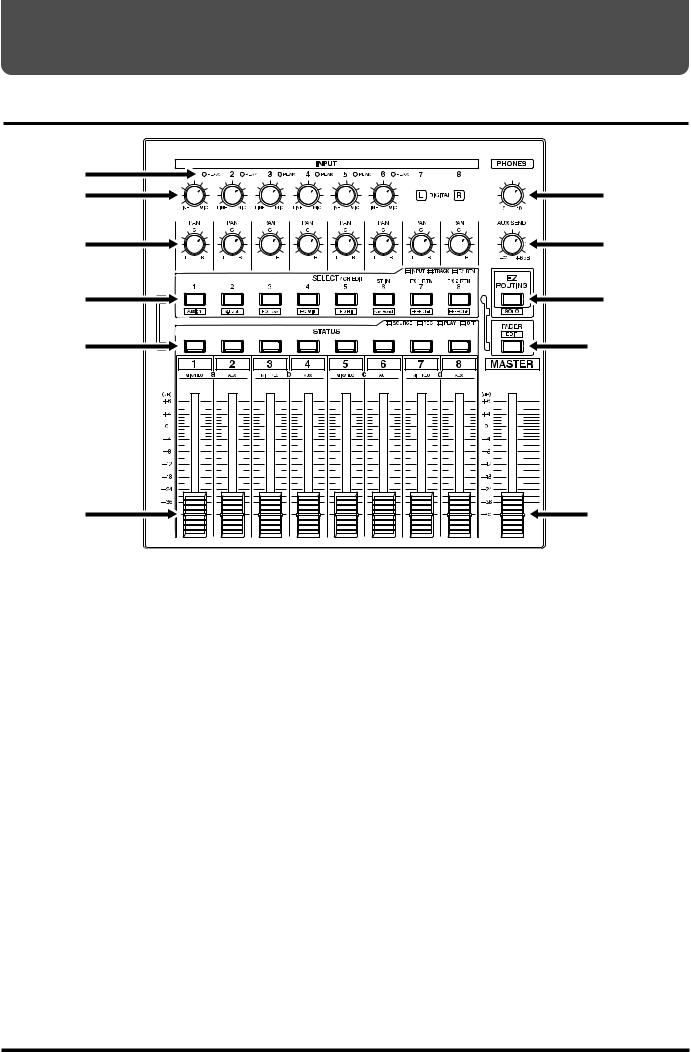
Front and Rear Panels
Mixer Section
1
2
3
4
5
6
1.PEAK Indicators
These indicators allow you to confirm the sound level input at the input jacks (1–6). They help you to determine the correct input level when adjusting the INPUT knobs. You will need to specify the level at which the indicators light beforehand (p. 61). The indicators are set at the factory to -6 dB.
2.INPUT Knobs
These knobs adjust the sensitivity of the input jacks (1–6). Turn a knob fully to the right for mic level (-50 dBu), and fully to the left for line level (+4 dBu).
7
8
9
10
11
4.SELECT/CH EDIT (Select/Channel Edit) buttons
Use these buttons when you wish to make settings for a mixer channel. The names of the parameter groups that can be set for each channel are printed below CH EDIT. To directly specify a particular group, you can hold down [SHIFT] and press the button for that group name.
When editing a song, use these buttons to select tracks for editing.
3.PAN Knobs
These knobs adjust the pan (location in the stereo output) of each channel.
14

Preparations
5.STATUS Buttons
These buttons switch the status of each track. The current status is shown by the button indicator.
SOURCE (orange):
The input source or track assigned to the channel is being output.
REC (blinking red):
Recording is selected for the track assigned to the channel. During playback, the track data is normally output.
REC (blinking red and orange):
Recording is selected for the track assigned to the channel. During playback, you will be able to listen to the source.
PLAY (green):
The track assigned to the channel will playback.
OFF (off):
The channel is muted (silent).
When pressed in combination with the SELECT/CH EDIT button, this selects the source or track to be assigned to a track for recording.
6.Channel Faders
Use these faders to adjust the volume level of each channel or track.
7.PHONES Knob
This knob adjusts the volume of the headphones.
8.AUX SEND knob
This knob adjusts the output level of the AUX SEND jacks.
9.EZ ROUTING/SOLO Button
This button opens the EZ Routing screen.
In conjunction with [SHIFT], this switches the Solo function on/off.
10. FADER/EDIT Button
Pressing this button alternately assigns each channel’s input mixer, track mixer and effect return mixer to the fader for that channel. The button indicator shows the current status.
INPUT (orange): Input Mixer
TRACK (green): Track Mixer
RETURN (red): Effect Return Mixer
In conjunction with [SHIFT], this accesses the Master Block setting page.
11. Master Fader
Use this fader to adjust the overall output level.
15
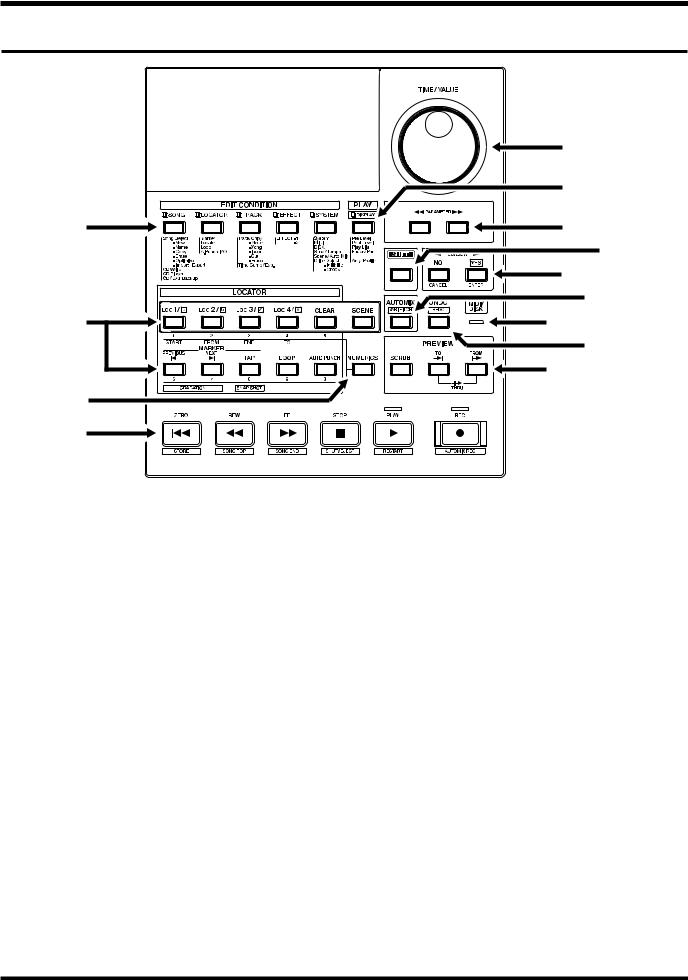
Preparations
Recorder Section
|
5 |
|
6 |
1 |
7 |
|
8 |
|
9 |
2 |
10 |
11 |
|
|
12 |
|
13 |
3 |
|
4 |
|
1.EDIT CONDITION Buttons
The functions and parameters of the VS-880EX are organized within these buttons. To use a desired operation, press the appropriate button.
2.LOCATOR Button
Pressing this button allows you to store or recall Locators and Markers or to store or recall Scenes (the mixer settings).
[LOC1/5]–[LOC4/8]: This button selects Locators and Scenes.
[CLEAR]: This button deletes Locators, Markers, and Scenes.
[SCENE]: This is pressed when storing, recalling, and deleting Scenes.
[PREVIOUS]: This button recalls the previous Marker.
[LOOP]: This button turns Loop Recording on and off. Pressed with the [LOC1/5]–[LOC4/8] buttons, it specifies the range to be recorded in Loop Recording.
[AUTO PUNCH]: This button turns Auto Punch-In Recording on and off. Pressed with the [LOC1/5]–[LOC4/8] buttons, it specifies the range to be recorded in Auto PunchIn Recording.
3.NUMERICS Button
Press this when you want to use the LOCATOR button for 10-key entry of Western numerals.
[NEXT]: This button recalls the next Marker.
[TAP]: This button is pressed to set Markers.
16

Preparations
4.Transport Control Buttons
These buttons are used to operate the recorder.
[ZERO]: This returns the current time to “00h00m00s00” (zero return).
[REW]: The current time is moved back only while this button is held down. This corresponds to the rewind button on a tape recorder.
[FF]: While the button is held down, the current time is moved forward. This corresponds to the fast-forward button on a tape recorder.
[STOP]: Stops recording or playback of the song.
[PLAY]: Starts recording or playback from the current time.
[REC]: Press this button to record a song.
5.TIME/VALUE Dial
In normal (playback) status, this dial adjusts the time of playback.
This is used to change the settings values for each parameter when settings are changed.
6.PLAY (DISPLAY) Button
Press this button to return to the screen that appears when the VS-880EX is turned on (normal playback status).
In conjunction with [SHIFT], this switches the item shown in the bar display.
7.PARAMETER Buttons
Use these buttons to switch the parameter display.
8.SHIFT Button
This button is pressed in conjunction with other buttons to access additional functions of those buttons.
9.CURSOR Buttons
Normally (i.e. in Play Condition), this dial is used to move the current time. When making settings (i.e. in Edit Condition), this dial is used to modify parameter values.
When a YES/NO response is required during an operation, use these button to reply.
[NO (CANCEL)]: This is pressed to cancel the current operation or exit the current screen.
[YES (ENTER)]: This is pressed to execute the current operation or select the current screen.
10. AUTOMIX (VARI PITCH) Button
This button switches the Auto Mix function on and off. The button indicator lights when Auto Mix is on.
In conjunction with [SHIFT], this switches the Varipitch function on/off.
11. MIDI/DISK Indicator
This indicator lights green when MIDI messages are being received, and red when data is being written or read on the disk drive. If both of these are occurring, the indicator lights orange.
12. UNDO (REDO) Button
Press this button to cancel a recording or editing step that you have made (Undo function). Pressed with [SHIFT], this button cancels the last performed Undo function (Redo function).
13. PREVIEW Button
Press this button to use the Preview function that plays back a specific length before and after the current location.
17
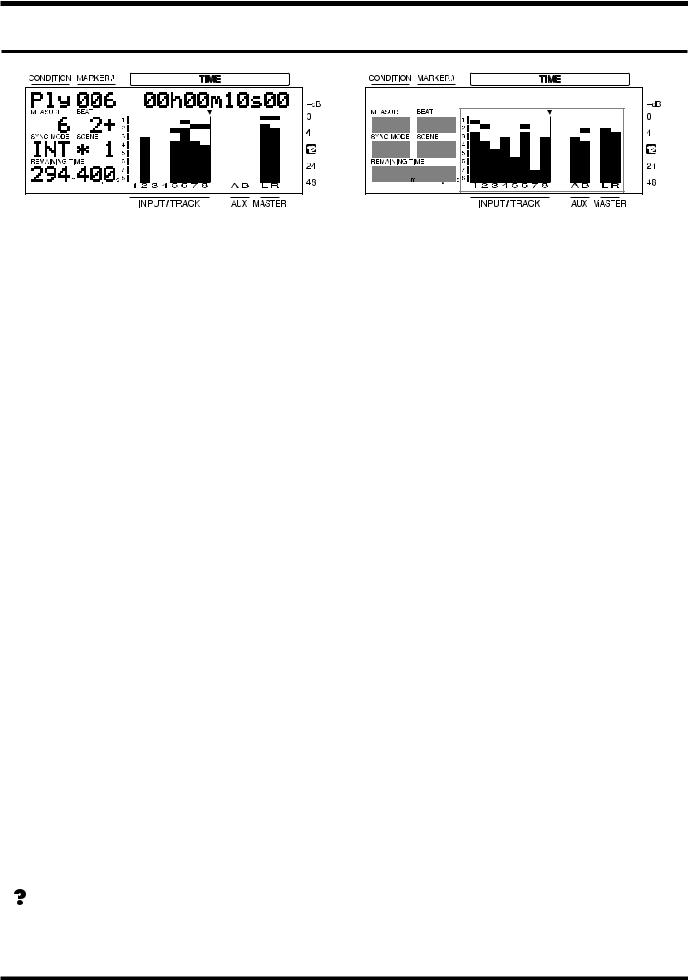
Preparations
Display section
1 |
|
2 |
|
3 |
4 |
5 |
6 |
7 |
8 |
9 |
1.CONDITION
This indicates the current condition.
PLY: Normal status (Play condition).
INn: Change the input mixer settings (n=1–8, a–d).
TRn: Change the track mixer settings (n=1–8 to a–d).
RTN: Change the return mixer settings.
MST: Change the master block settings.
SNG: Song edit
LOC: Locator edit
TRK: Track edit
FX: Effect edit
SYS: System edit
*If Song Protect (p.64) is turned on, the Play Condition display will be “Ply.”
*The input/track mixer display will indicate 1–8 for channels whose Channel Link is OFF, and a–d for channels which are turned ON.
2.MARKER # (marker number)
This shows the marker number for the current time. If a mark point has not been assigned to the current time, the closest marker number located before the current time will be shown.
4.MEASURE
This shows the current measure of the song.
5.BEAT
This shows the current beat of the song.
6.SYNC MODE
This indicates the current sync mode (method of synchronization).
7.SCENE
This shows the currently used scene number (mixer setting). An asterisk “ ” shown at the beginning of the scene number indicates that the current mixer settings have been modified since the scene was recalled.
8.REMAINING TIME
This shows the remaining length of time available for recording.
9.Bar display
In normal condition, the item selected by [DISPLAY (PLAY)] are shown graphically. While you are making a setting, data for the setting being made is displayed graphically.
3.TIME
The current time of the song is displayed as SMPTE time code.
SMPTE Time Code (Appendices p. 124)
18

Preparations
Rear Panel
1
|
|
|
|
|
|
|
|
|
|
|
|
|
|
|
|
|
|
|
|
|
|
|
|
|
|
|
|
|
|
|
|
|
|
|
|
|
|
|
|
|
|
|
|
|
|
|
|
|
|
|
|
|
|
|
|
|
|
|
|
|
|
|
|
|
|
|
|
|
|
|
|
|
|
|
|
|
|
|
|
|
|
|
|
|
|
|
|
|
|
|
|
|
|
|
|
|
|
|
|
|
|
|
|
|
|
|
|
|
|
|
|
|
|
|
|
|
|
|
|
|
|
|
|
|
|
|
|
|
|
|
|
|
|
|
|
|
|
|
|
|
|
|
|
|
|
|
|
|
|
|
|
|
|
|
|
|
|
|
|
|
|
|
|
|
|
|
|
|
|
|
|
|
|
|
|
|
|
|
|
|
|
|
|
|
|
|
|
|
|
|
|
|
|
|
|
|
|
|
|
|
|
|
|
|
|
|
|
|
|
|
|
|
|
|
|
|
|
|
|
|
|
|
|
|
|
|
|
|
|
|
|
|
|
|
|
|
|
|
|
|
|
|
|
|
|
|
|
|
|
|
|
|
|
|
|
|
|
|
|
|
|
|
|
|
|
|
|
|
|
|
|
|
|
|
|
|
|
|
|
|
|
|
|
|
|
|
|
|
|
|
|
|
|
|
|
|
|
|
|
|
|
|
|
|
|
|
|
|
|
|
|
|
|
|
|
|
|
|
|
|
|
|
|
|
|
|
|
|
|
|
|
|
|
|
|
|
|
|
|
|
|
|
|
|
|
|
|
|
|
|
|
|
|
|
|
|
|
|
|
|
|
|
|
|
|
|
|
|
|
|
|
|
|
|
|
|
|
|
|
|
|
|
|
|
|
|
|
|
|
|
|
|
|
|
|
2 |
3 |
4 |
5 |
|
|
|
|
|
|
|
|
|
|
|
|
|
|
|
|
|
|
|
|
|||||||||
1.POWER Switch
This switch turns power of the VS-880EX on and off.
5.DIGITAL Connectors
The VS-880EX features both coaxial and optical digital I/O connectors (conforming to S/P DIF).
2.AC IN (AC Inlet)
Connect the included power cable here.
3.SCSI Connector
This is a DB-25 type SCSI connector for connecting disk drives such as a Zip disk drive or a CD-R drive.
4.MIDI Connectors (IN, OUT/THRU)
External MIDI devices (MIDI controllers, MIDI sequencers, etc.) can be connected here.
IN: This connector receives MIDI messages. Connect it to the MIDI OUT connector of the external MIDI device.
OUT/THRU: This connector can be used either as a MIDI OUT or as a MIDI THRU connector. With the factory settings, it will function as a MIDI OUT connector, which means it is set to transmit MIDI messages.
IN: This inputs a digital audio signal (stereo). You can select either the coaxial input connection or the optical connection.
OUT: This outputs a digital audio signal (stereo). Here you can use both the coaxial connector and the optical connector simultaneously, and each can carry a different signal.
S/P DIF (Appendices p. 124)
*To record a digital audio signal, it is not sufficient to simply connect a digital audio device to the DIGITAL IN connector. When inputting a digital audio signal, refer to “Recording Digital Signals” (p. 55).
*It is not able to input or output analog audio signals.
19
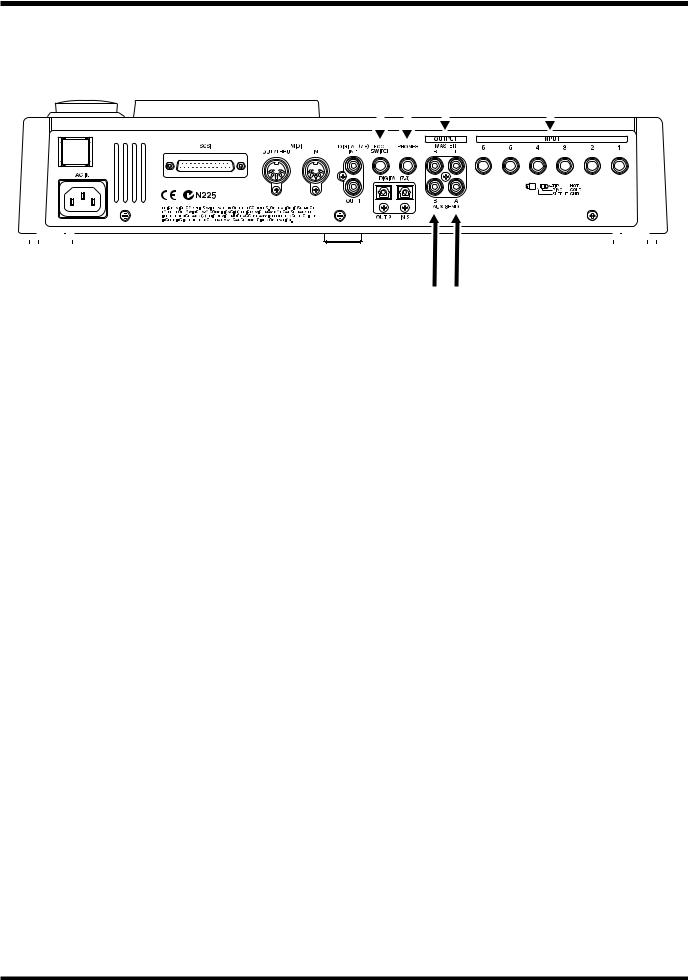
Preparations
|
6 7 |
8 |
|
11 |
|
|
||||||||||||||||||||||||||||
|
|
|
|
|
|
|
|
|
|
|
|
|
|
|
|
|
|
|
|
|
|
|
|
|
|
|
|
|
|
|
|
|
|
|
|
|
|
|
|
|
|
|
|
|
|
|
|
|
|
|
|
|
|
|
|
|
|
|
|
|
|
|
|
|
|
|
|
|
|
|
|
|
|
|
|
|
|
|
|
|
|
|
|
|
|
|
|
|
|
|
|
|
|
|
|
|
|
|
|
|
|
|
|
|
|
|
|
|
|
|
|
|
|
|
|
|
|
|
|
|
|
|
|
|
|
|
|
|
|
|
|
|
|
|
|
|
|
|
|
|
|
|
|
|
|
|
|
|
|
|
|
|
|
|
|
|
|
|
|
|
|
|
|
|
|
|
|
|
|
|
|
|
|
|
|
|
|
|
|
|
|
|
|
|
|
|
|
|
|
|
|
|
|
|
|
|
|
|
|
|
|
|
|
|
|
|
|
|
|
|
|
|
|
|
|
|
|
|
|
|
|
|
|
|
|
|
|
|
|
|
|
|
|
|
|
|
|
|
|
|
|
|
|
|
|
|
|
|
|
|
|
|
|
|
|
|
|
|
|
|
|
|
|
|
|
|
|
|
|
|
|
|
|
|
|
|
|
|
|
|
|
|
|
|
|
|
|
|
|
|
|
|
|
|
|
|
|
|
|
|
|
|
|
|
|
|
|
|
|
|
|
|
|
|
|
|
|
|
|
|
|
|
|
|
|
|
|
|
|
|
|
|
|
|
|
|
|
|
|
|
|
|
|
|
|
|
|
|
|
|
|
|
|
|
|
|
|
|
|
|
|
|
|
|
|
|
|
|
|
|
|
|
|
|
|
|
|
|
|
|
|
|
|
|
|
|
|
|
|
|
|
|
|
|
|
|
|
|
|
|
|
|
|
|
|
|
|
|
|
|
|
|
|
|
|
|
|
|
|
|
|
|
|
|
|
|
|
|
|
|
|
|
|
|
|
|
|
|
|
|
|
|
|
|
|
|
|
|
|
|
|
|
|
|
|
|
|
|
|
|
|
|
|
|
|
|
|
|
|
|
|
|
|
|
|
|
|
|
|
|
|
|
|
|
|
|
|
|
|
9 10
6.FOOT SWITCH Jack
An optional foot switch (such as the DP-2 or the BOSS FS-5U) can be connected here when you want to control recorder operations, mark point settings, and punch in/out operations, and so on with a foot switch. With the factory settings, a foot switch is set to start and stop the recorder.
7.PHONES Jack
An optional set of headphones can be connected here.
The PHONES jack outputs the same sound as the
MONITOR jack.
8.MASTER Jacks (L, R)
9.AUX SEND Jack A
10.AUX SEND Jack B
These are output jacks for analog audio signals (RCA phono type).
With the factory settings, all signals are output from the MASTER OUT jacks, and there is no output from the AUX (A and B) SEND jacks. The output is determined by the block settings of the mixer’s master section and the settings of each channel.
11. INPUT Jacks (1–6)
These are input jacks for analog audio signals. These are balanced phone jacks, the input sensitivity of each jack is adjusted by the INPUT knobs on the top panel.
20

Chapter 1 Before You Start (VS-880EX Terminology)
This chapter explains basic concepts, internal structure, and basic operation that you will need to know in order to operate the VS-880EX. Please read this chapter thoroughly to gain a better understanding of the VS-880EX.
Saving and Managing Data
Managing Disk Contents (Partitioning)
The VS-880EX saves all of the data such as — performance data, mixing data, system data, etc. — on the disk drive. Thus, it cannot operate without either having an internal disk or being connected to a Zip drive with a SCSI connector. Furthermore, the hard disk or
Zip drive used by the VS-880EX cannot be used by another device.
The VS-880EX is able to manage which 500 MB or 1000 MB of disk space at once. If you use a disk drive with a capacity that is larger than this, you will need to divide it into two or more.
Each of these area is refered as the “partition.” Up to 4 partitions can be created in one disk drive. For creating songs in a enough space, we recommend you to set the partitions to 1000 MB.
Ex. 1: When the disk drive is 810 MB, and the partition size is 1000 MB.
Disk Drive
(810MB)
Partition
(810MB)
Ex. 2: When the disk drive is 1.4 GB, and the partition size is 1000 MB.
Disk Drive
(1.4GB)
Partition 0 |
|
Partition 1 |
(1000MB) |
|
(400MB) |
|
|
|
Ex. 3: When the disk drive is 2.1 GB, and the partition size is 500 MB.
|
|
Disk Drive |
|
||
|
|
(2.1GB) |
|
||
|
|
|
|
|
|
|
Partition 0 |
|
|
Partition 1 |
|
|
(500MB) |
|
|
(500MB) |
|
|
|
|
|
|
|
|
|
|
|
|
|
|
Partition 2 |
|
|
Partition 3 |
|
|
(500MB) |
|
|
(500MB) |
|
|
|
|
|
|
|
|
unusable |
|
|
|
|
|
(100MB) |
|
|
|
|
|
|
|
|
|
|
Ex. 4: When the disk drive is 2.1 GB, and the partition size is 1000 MB.
Disk Drive
(2.1GB)
Partition 0 |
|
Partition 1 |
(1000MB) |
|
(1000MB) |
|
|
|
Partition 2
(100MB)
Each partition on the VS-880EX’s disk drive is treated as an independent drive, with each partition automatically given a partition number (0–3). When a single hard disk has multiple partitions, you can specify which partition of which drive will be used. This disk drive partition currently used is referred to as the current drive.
1 Chapter
21

Chapter 1 Before You Start (VS-880EX Terminology)
Specify the Disk Which will be Used for Recording/Playback (Drive Select)
1.Press [SYSTEM] several times until “SYS Drive Select” appears in the display.
2.Press [YES].
3.Use the TIME/VALUE dial to select the desired disk drive. The internal hard disk is shown as “IDE:*” and external disk drives are shown as “SC0:*–SC7:*” (the number is the SCSI ID number). The number following each disk drive name is the partition number. For example if you wish to select internal hard disk partition 1, you would select “IDE:1.”
4.Press [YES].
A confirmation message appears on the screen.
5. Press [YES].
“STORE Current?” (Store the current song?) appears in the display.
6.If you wish to save the current song, press [YES]; if not, then press [NO]. If you have selected a demo song, then press [NO].
7.After you have switched the current drive, return to Play condition.
*If you wish to use hard disks or song data on both the VS880EX and the VS-880/840/1680, because of factors such as differing partition sizes and numbers of tracks, there will be limitations as to what you can do. For more detailed information, please see “Compatibility” (p. 136).
*The VS-880EX accepts installation of Internal hard disks (desinated by Roland). For simultaneous recording or playback of a number of tracks, for getting more out of the available hard disk space, and in order to get the fullest performance in general from the VS-880EX, we recommend using the 2.1 GB or larger Internal Hard Disk.
The Location Where a Performance is
Recorded (Song)
The location where a performance data is recorded is refered to as the song. For example on a cassette MTR, this would correspond to cassette tape. Up to 200 songs can be created in each partition. Normally, you should set the partition size at 1000 MB. When dealing with large numbers of songs at the same time, setting the partition size to 500 MB is recommended. The song currently being recorded, played back, or edited is referred to as the current song. Following data are included in a song.
•All data recorded on V-tracks
•MIDI clocks of the sync track
•Points specified within songs (locator, marker, punch-in/out points, loop-in/out points) (p. 36)
•Scenes (mixer settings)
•Vari Pitch settings (p. 152)
•System settings (system, MIDI, disk, sync, Scene) (p. 164)
•Effect settings
•Auto Mix Data
Sources, Tracks, and Channels
On the VS-880EX, the recorder section and mixer section use term sources, tracks, and channels. These terms may appear similar to each other, and will be confusing unless their differences are clarified.
Source: A signal which is input to the mixer section or recorded in the recorder section. On the VS-880EX, this term refers in particular to the signals of the analog input jacks (1–6) and the digital in connector.
Track: A signal that is being input to or output from the recorder section. It also refers to the location of a signal that is being recorded onto or played back from the hard disk.
Channel: A signal that is being input to or output from the mixer section. This term refers in particular to the faders and buttons of the mixer section on the top panel.
22

Chapter 1 Before You Start (VS-880EX Terminology)
About Events
The smallest unit of memory used by the VS-880EX to store recorded results on disk is called an event. A newly created song is provided approximately 12,800 events.
For each track, one recording pass uses two events. Operations such as punch-in/out or track copy also use up events. The number of events that are used up will fluctuate in a complex way. For example, auto mix (p. 142) uses up 5 events for each Marker.
Even when your disk has ample free space, one song can use up all the available events, in which case no more data could be recorded to the song.
Remaining number of Events can be saved with the following procedures. Please try the most appropriate one with your situation.
● Execute Song Store (p. 32)
Please Execute Song Store if in UNDO condition ([UNDO] indicator is lit.). Events served for REDO will be released. But please note that you cannot cancel (REDO) the last UNDO if you once execute STORE.
● Execute Song Optimize (p. 156)
Please execute Song Optimize if you have done a lot of Punch In recording. Events served for unnecessary audio data will be released. But please note that you can only do single level UNDO.
● Erase AutoMix data (p. 146)
If you have recorded AutoMix data, erase unnecessary data. Events served for unnecessary AutoMix data will be released.
1 Chapter
23
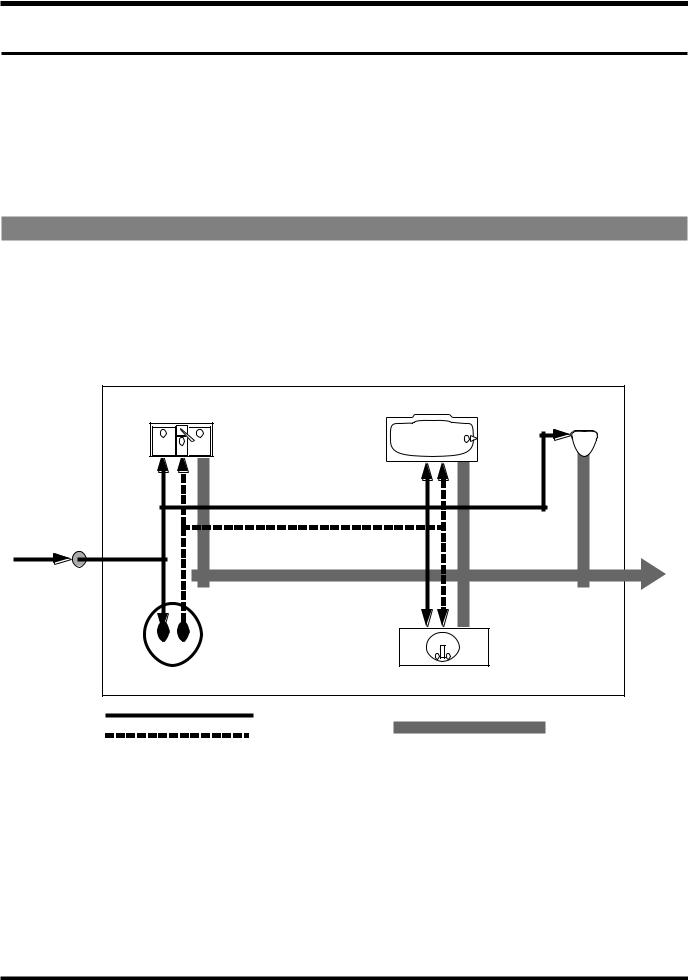
Chapter 1 Before You Start (VS-880EX Terminology)
Mixer Section
The digital mixer specifies input or output status of the recorder section. The VS880EX contains an Input Mixer located before the recorder section, a Track Mixer located after the recorder section, an Effect Return Mixer which controls the effect return and Stereo In (p. 152), and a Master Block which determines the output jacks from which the signal of each mixer will be output.
*For more detailed information about the mixer section, please refer to the “Mixer Section Block Diagram” (Appendices p. 120).
Signal Flow (Buses)
On the VS-880EX, signals flow through buses. buses are shared lines through which multiple signals can be routed efficiently to multiple tracks or channels. It may be easier to understand this if we use the analogy of water pipes.
For example, the water that is supplied by the water company to your house is branched to a variety of locations within the house (kitchen, bathroom, toilet, etc.). The water that is used at each of these locations is then collected into the sewer, and carried away.
INPUT to house from water line
|
Your House |
Bathtub |
Kitchen Sink |
|
|
INPUTS |
OUTPUT |
INPUTS |
OUTPUT INPUT |
OUTPUT |
|
OUTPUT |
|
INPUTS |
Water Heater |
Bath Sink |
|
|
|
Cold Water (Bus) |
|
Hot Water (Bus) |
Toilet
INPUT 
OUTPUT |
OUTPUT |
|
|
|
to |
OUTPUT
Drain (Bus)
If we think of the VS-880EX as the house, the water being supplied from the water company corresponds to inputs such as mic or guitar. Some of these inputs are sent to recording tracks and are recorded. Other portions are sent to the effects, and reverb or chorus are applied before they are output.
The basic principle of the VS-880EX is that by specifying in this way from where and to where the common lines run, you can determine which input signals will be recorded on which track or sent to which effects, and where they will be output.
24

Chapter 1 Before You Start (VS-880EX Terminology)
The VS-880EX has the following buses.
RECORDING Bus:
Signals assigned to the RECORDING bus are routed to the recorder section to be recorded. There are eight channels which can be assigned to the output of the input mixer, track mixer, and effects (Return). Signals assigned to the RECORDING bus cannot be routed to the MIX bus.
MIX Bus:
Signals assigned to the MIX bus are sent to the MASTER jacks for monitoring. It has two channels (L and R), and can take output signals from the input mixer, track mixer, and effects (Return). Signals assigned to the MIX bus cannot be routed to the RECORDING bus.
EFFECT Bus:
Signals assigned to the EFFECT bus are sent to the effect to apply effects added to them. It has two channels (FX1, FX2), and can process signals from the input mixer and the track mixer. Signals assigned to the RECORDING bus as well as the MIX bus can also be routed to the EFFECT bus.
AUX Bus:
Signals assigned to the AUX bus are routed to the AUX SEND jacks to allow addition mixes for monitoring. This bus features two channels (AUX A, AUX B), and can take signals from the input mixer and the track mixer. Signals assigned to the RECORDING bus as well as the MIX bus can also be routed to the AUX bus. This is convenient if, for example, you want to connect an external effects device, or when you want an addition output separate from that of the MASTER Out jacks (individual out).
1 Chapter
25

Chapter 1 Before You Start (VS-880EX Terminology)
Input Mixer
Input mixer is placed before the recorder section, and correspond to the external input sources (INPUT 1–6, DIGITAL IN L/R).
Input Mixer (Channel 1–6, DIGITAL L/R)
INPUT 1 |
EQ1 |
INPUT 2 |
EQ2 |
INPUT 3 |
EQ3 |
INPUT 4 |
EQ4 |
INPUT 5 |
EQ5 |
INPUT 6 |
EQ6 |
DIGITAL IN L (7) |
EQ7 |
DIGITAL IN R (8) |
EQ8 |
Fader1 |
Fader2 |
Fader3 |
Fader4 |
Fader5 |
Fader6 |
Fader7 |
Fader8 |
Pan1 |
Pan2 |
Pan3 |
Pan4 |
Pan5 |
Pan6 |
Pan7 |
Pan8 |
 MIX L/R (MASTER)
MIX L/R (MASTER)

 REC 1 (Recorder)
REC 1 (Recorder)

 REC 2 (Recorder)
REC 2 (Recorder)

 REC 3 (Recorder)
REC 3 (Recorder)

 REC 4 (Recorder)
REC 4 (Recorder)

 REC 5 (Recorder)
REC 5 (Recorder)

 REC 6 (Recorder)
REC 6 (Recorder)

 REC 7 (Recorder)
REC 7 (Recorder)

 REC 8 (Recorder)
REC 8 (Recorder)
The output of each channel is assigned to tracks to be recorded. Channels not assigned to tracks are output directly from the MASTER jacks. Additionally, the status of tracks with signals assigned to them when not in record standby (STATUS indicator blinking red), also are output from the MASTER jacks. At this time, the following signals are assigned to the channel faders.
Channels 1–6: INPUT jacks 1–6
Channels 7–8: DIGITAL IN connector L/R
26
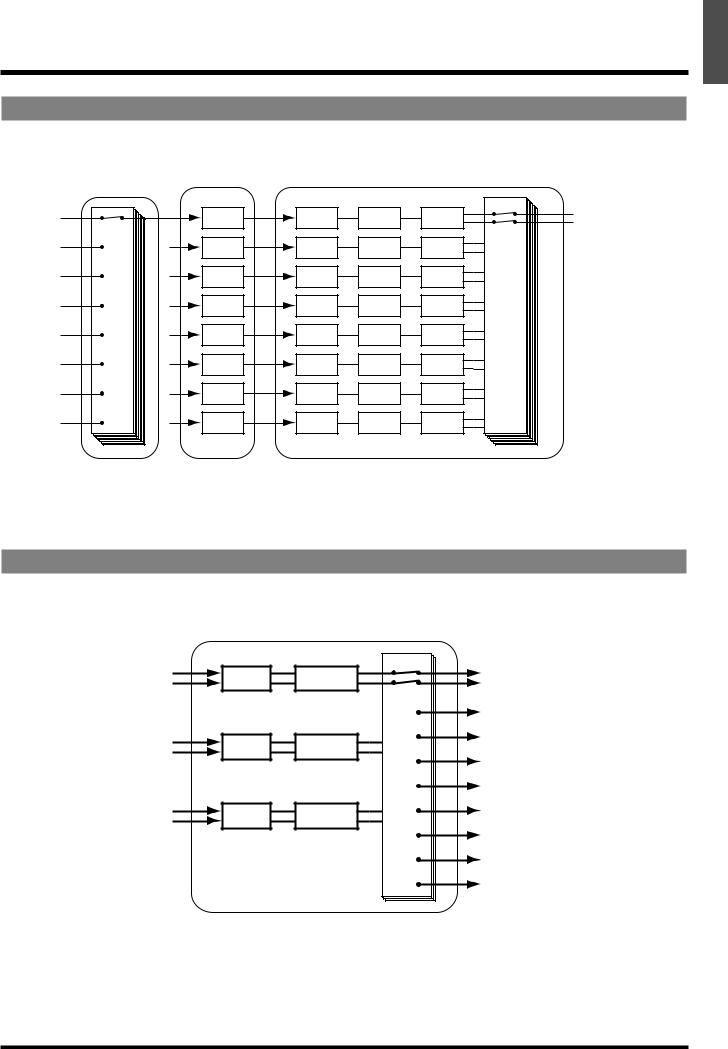
Chapter 1 Before You Start (VS-880EX Terminology)
Track Mixer
Track mixer is placed after the recorder section, and correspond to the tracks (1–8).
REC 1 
REC 2 
REC 3 
REC 4 
REC 5 
REC 6 
REC 7 
REC 8 
Recorder |
Track1 |
Track2 |
Track3 |
Track4 |
Track5 |
Track6 |
Track7 |
Track8 |
Track Mixer (Track 1–8)
EQ1 |
Fader1 |
Pan1 |
EQ2 |
Fader2 |
Pan2 |
EQ3 |
Fader3 |
Pan3 |
EQ4 |
Fader4 |
Pan4 |
EQ5 |
Fader5 |
Pan5 |
EQ6 |
Fader6 |
Pan6 |
EQ7 |
Fader7 |
Pan7 |
EQ8 |
Fader8 |
Pan8 |
 MIX L/R (MASTER)
MIX L/R (MASTER)

 REC 1 (Recorder)
REC 1 (Recorder)

 REC 2 (Recorder)
REC 2 (Recorder)

 REC 3 (Recorder)
REC 3 (Recorder)

 REC 4 (Recorder)
REC 4 (Recorder)

 REC 5 (Recorder)
REC 5 (Recorder)

 REC 6 (Recorder)
REC 6 (Recorder)

 REC 7 (Recorder)
REC 7 (Recorder)

 REC 8 (Recorder)
REC 8 (Recorder)
All of the tracks are output from the MASTER jacks. Additionally, tracks can also be routed back to the RECORDING bus for overdubbing, or re-rerecording. In this status, the channel faders 1–8 correspond respectively to Tracks 1–8.
Effect Return Mixer
This mixer adjusts the return level/balance from effects connected in send/return fashion, and the level/balance of the stereo input.
Stereo In
FX1 Return
FX2 Retuen
FX Return Mixer (Channel 6–8) |
|
|
Fader6 |
Balance6 |
MIX L/R (MASTER) |
|
|
REC 1 (Recorder) |
Fade7 |
Balance7 |
REC 2 (Recorder) |
|
||
|
|
REC 3 (Recorder) |
|
|
REC 4 (Recorder) |
Fader8 |
Balance8 |
REC 5 (Recorder) |
|
||
|
|
REC 6 (Recorder) |
|
|
REC 7 (Recorder) |
|
|
REC 8 (Recorder) |
Each channel is output from the MASTER jacks. It is also possible to assign them to the recording bus for recording. In this case, the channel faders correspond to the following signals.
Channel 6: |
The INPUT jack assigned to Stereo In |
Channel 7: |
FX1 return |
Channel 8: |
FX2 return |
1 Chapter
27

Chapter 1 Before You Start (VS-880EX Terminology)
Switching the Fader Functions
On the VS-880EX, it is able to adjust Input mixer or Track mixer by switching the function of the channel faders on the top panel. Pressing [FADER] on the top panel toggles between the input mixer and the track mixer. The FADER indicator indicates which mixer is currently selected.
lighting orange: Input Mixer
lighting green: Track Mixer
lighting red: Effect Return Mixer
Master Block
This selects the jacks or connectors connected to external equipment to which the output of each mixer is sent.
|
|
|
Masterblock |
|||||
MIX L/R |
|
|
|
|
|
MASTER L/R |
||
|
|
|
|
|
||||
|
|
|
|
|
||||
|
|
|
|
|
|
|
|
|
AUX A, B |
|
|
|
|
|
|
PHONES L/R |
|
|
|
|
|
|
||||
|
|
|
|
|
|
|
||
|
|
|
|
|
|
|
|
|
FX1 L/R |
|
|
|
|
|
AUX A, B |
||
|
|
|
|
|
||||
|
|
|
|
|
|
|
|
|
|
|
|
|
|
|
|
||
|
|
|
|
|
|
|
|
|
FX2 L/R |
|
|
|
|
|
DIGITAL OUT 1 |
||
|
|
|
|
|
||||
REC bus |
|
|
|
|
|
|
||
|
|
|
|
|
|
DIGITAL OUT 2 |
||
|
|
|
|
|
|
|||
|
|
|
|
|
|
|
|
|
|
|
|
|
|
|
|
|
|
|
|
|
|
|
|
|
|
|
|
|
|
|
|
|
|
|
|
Recorder Section
Differences with a Tape-Type MTR
Unlike DAT recorders, which use tape, digital disk recorders record performances (sounds) on a disk, as do MD recorders. Music that is recorded on disk can be recalled and played back immediately, no matter where it is located on the disk. This is also obvious from the difference in speed at which you can move to the beginning of a song on a DAT recorder and on an MD recorder.
The ability to freely move to data regardless of the time or sequence at which it was recorded is known as random access. In contrast, having to move to data in the order of the time or sequence at which it was recorded is known as sequential access.
random access |
sequential access |
28
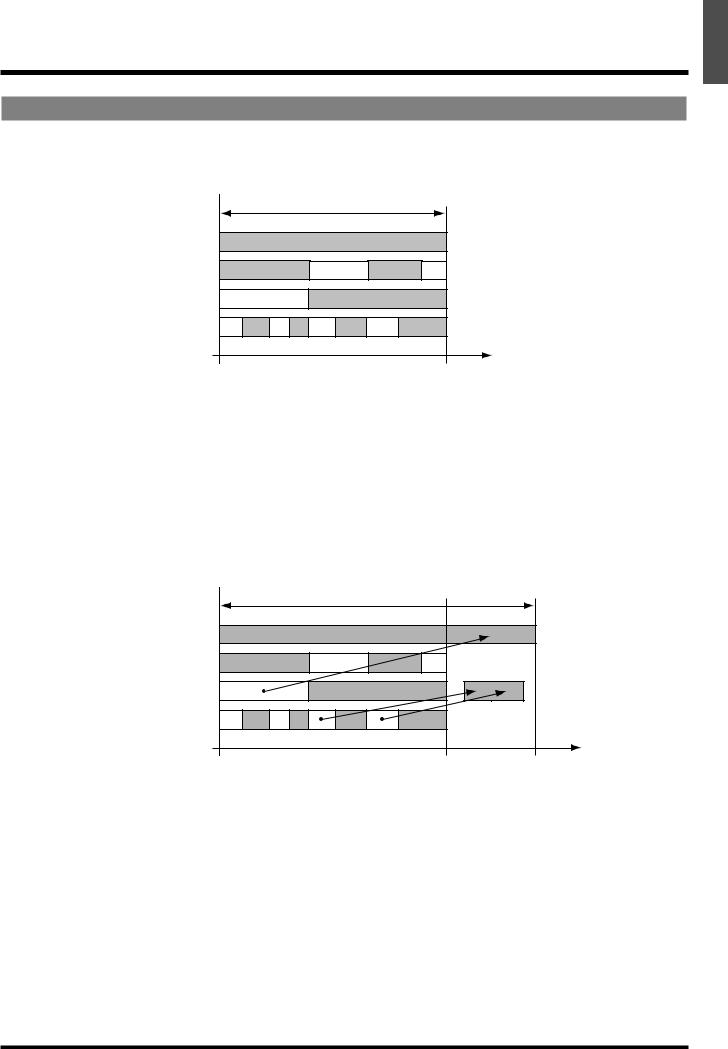
Chapter 1 Before You Start (VS-880EX Terminology)
Track Minutes and Recording Time
With cassette tape recorders, the amount of time you can record on a tape is predetermined by the length of that tape. Moreover, any unused portion of the tape is wasted.
available recording time
Track 1
Track 2
Track 3
Track 4
00h00m00s00 |
00h30m00s00 |
Time
In Case of Tape Recording (using 30-minute tape)
In contrast, with disk recording, although available recording time is determined by the amount of disk space, only the disk space used in recording is taken, and beyond that, has no affect on the disk’s remaining free space. Thus, depending on how you use tracks and phrases, the amount of available recording time will vary. Thus, this calls for a standard unit corresponding to the time of one continuous monaural signal recorded to one track. This unit is referred to as a track minute.
|
available recording time |
|
Track 1 |
|
|
Track 2 |
|
|
Track 3 |
|
|
Track 4 |
|
|
00h00m00s00 |
00h30m00s00 |
00h40m00s00 |
|
|
Time |
In Case of Disk Recording
1 Chapter
29
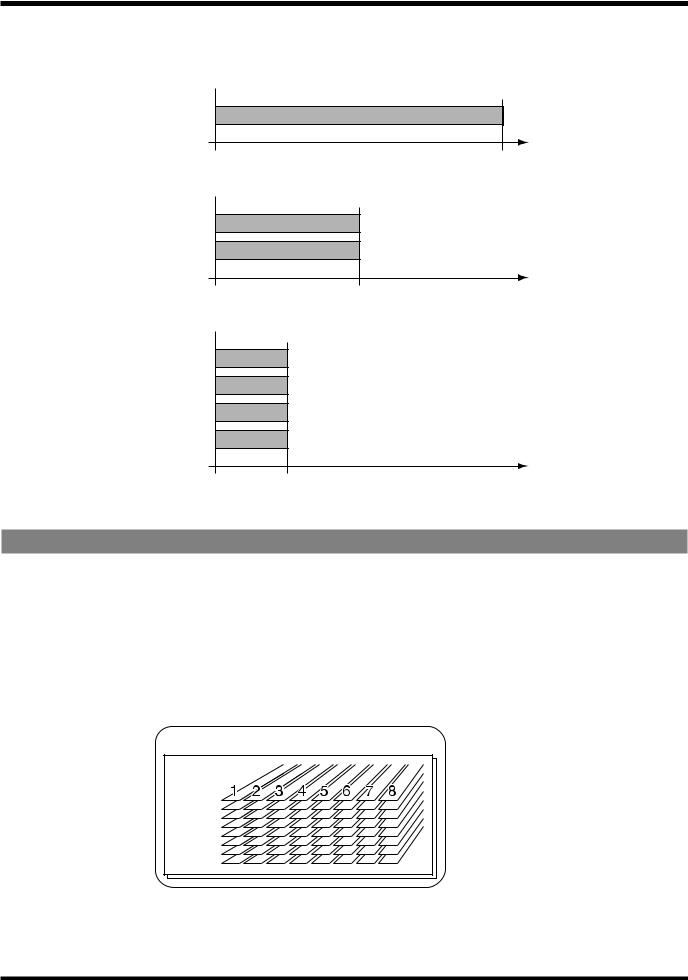
Chapter 1 Before You Start (VS-880EX Terminology)
For example, 10 track minutes be used for 10 minutes of monaural recording, 5 minutes of stereo recording, 2 minutes and 30 seconds of recording on four tracks, and so on.
Track 1
00h00m00s00 |
00h10m00s00 |
|
Time |
Track 1
Track 2
00h00m00s00 |
00h05m00s00 |
Time |
Track 1
Track 2
Track 3
Track 4
00h00m00s00 00h02m30s00 |
Time |
Auxiliary Tracks for Each Track
The VS-880EX provides 8 playback tracks, and allows 8 tracks to be recorded simultaneously. Each track is composed from the features 8 supplementary tracks, each on of which can be used for recording or playback. These auxiliary tracks are called V-tracks.
One song can contain two sets (banks) of 64 V-tracks (these 8 tracks x 8 V-tracks). In other words, a maximum of 8 tracks x 8 V-tracks x 2 banks = 128 performance tracks can be recorded. For actual recording/playback, you will specify the bank that you wish to use, and then select one of the V-tracks.
Song
V-Track Bank A, B
V-Track1 |
2 |
3 |
4 |
5 |
6 |
7 |
8 |
*This Owner’s Manual provides a blank virtual track sheet to help you keep track of your virtual track recordings (p. 129). Feel free to copy the sheet to use when you record.
30
